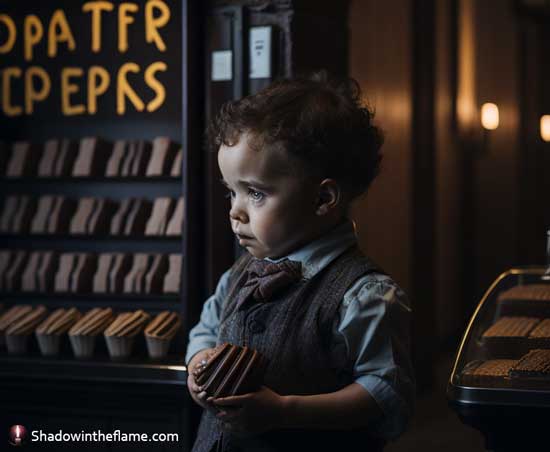
How it All Started
Once upon a time there was a sweet shop next door to an infants’ school. One day a big poster appeared in the shop window advertising a new chocolate bar. It looked scrumptious and all the children would stop on their way to school and drool over the picture of the chocolate bar cut in half with the red white and blue cream dripping to the floor.
It came in three sizes a very small “kidsbar”, a family size block and a party pack which was huge.
First one boy bought a kidsbar and took it to school and the next day almost every child had pestered their parents to give them enough money to buy one. There were some very ingenious stories told that night.
Soon one enterprising lad realized that if 5 kids put their money together, they could buy a family block and each one would get more pieces than if they bought a kidsbar. He convinced four of his friends to join him and together they purchased a family sized block.
They all got four extra squares but they found there were two left over and five of them. Then the enterprising lad said “well seeing as it was my idea I should get the extra two squares”. No body liked the idea much but neither could they think of a better excuse to claim the extra squares for themselves so they agreed.
This set the precedent so every time they bought a family block the boy got two extra squares, which he sold to kids who could not afford to buy their own bar.
Greed or Good Business Sense?
One day he worked out that if he got two more people to join the group they could afford to move up to the party pack and they would all get two additional squares for the same money but with the money he had earned on the extra two squares he had been selling he could buy two portions.
So he got one more person to join the group and paid for two portions himself. Then he found that there were four squares left over but as he was paying for two portions and the group purchase was his idea he claimed the extra squares. No body could think of a good reason why they should get the squares so they agreed.
Now he had one big portion plus four squares to sell and at the price he was getting for each individual square he found he got all his money back and he had a portion to eat.
Competition is Good – Right?
Soon the other boys in the group realized they could make money selling some of their squares of chocolate and still have a kidsbar’s worth to eat themselves. The enterprising lad saw this competition and realized he was “losing money” because they were making sales from his idea.
So he sold all his chocolate for one week until he had enough to buy three party packs and then announced that the partnership was over. The boys thought they could compete but the enterprising lad dropped the price of his squares and they lost money because they couldn’t sell their squares and then to add insult to injury, they melted.
With the competition gone, the boy raised his prices and added a new brand of chocolate bar, a very expensive Belgian chocolate that the kids loved. Every one knew that Belgian chocolate was much more expensive so they didn’t mind paying more for a square and the boy found he could make more profit selling less of this one than he did on the other bar.
With his thriving business the boy attracted a lot of friends who he would reward with the odd square of chocolate if they pleased him. But if someone didn’t please him, he had lots of friends willing to make their life a misery.
Life was good. He was now the most popular boy in school. The kids looked up to him and he kept the teachers happy with a regular present, of chocolate of course. He was in the perfect business, no matter what ethnic background, what color or religion everyone liked chocolate.
While the other children were out playing he was at home dreaming up ways to expand his empire.
The Business Expands
One night he realized that he was not the only one making good money from his sales and the next day he made sure the sweet shop owner appreciated how much his efforts had increased the shop’s sales. He didn’t need to stress how many other shops sold chocolate.
The shop owner offered him a discount and the boy accepted but added that he would, from now on, pay for all his purchases at the end of the month. Every day the boy would pick up his chocolate order but because he didn’t have to pay for it until the end of the month he started to see his money pile up. He found it more exciting than sport or girls.
His mind turned to how to maximize sales and his profits. He realized that many of the kids couldn’t save the money to buy a square because they would spend it on something else before they had saved enough. So he offered them a savings plan. They could give him the money and when they had “saved” enough with him he would give them the chocolate. Getting his money in advance also meant that he could pay his monthly account without dipping into his cash that was accumulating in the tin. Life was good.
One day a lad asked the boy “Why do I have to wait? Can’t you give me the square now and I will pay you off”. The boy could see that the lad really wanted the square now and asked if he was willing to pay a little bit extra as he had to outlay the money today but would not get repaid for over a week. The lad readily agreed and the boy found he could make more profit selling the pieces this way.
Soon everyone was getting their chocolate and sweets from the boy on credit. His motto was “Eat Now Pay Later” and it proved to be very popular.
Some people wanted more chocolate but they hadn’t paid off the previous purchase so the boy, not wanting to miss out on another sale, sold them more and increased the period for making the payments – adding one extra payment to cover his “costs”.
Houston We Have a Problem
Then one month he got his bill from the shop but found he didn’t have enough cash to pay it. He talked the shop owner into giving him extra time and took more chocolate to sell.
He realized that he could not give more credit to people who already owed him for past purchases so he told his customers they had to pay off their loans to get more chocolate. This made them very unhappy and some of them decided not to pay at all which had a bad impact on the boy’s cash flow. He also could not sell the new chocolate he had taken from the shop and one day it melted.
Now he couldn’t sell it and he couldn’t give it back but he had to pay for it.
As more kids saw that they could just stop making payments the boy’s cash flow dropped dramatically and he lost a lot of his friends. When the shop keeper came looking for him he appealed to the kids to help him by paying what they owed but they couldn’t think of a good reason why they should suffer to help him.
The head master got very angry when he heard what had happened and gave a stirring speech about greed at assembly. He threatened the boy with expulsion but didn’t get the support of the school board who thought the boy had learned his lesson. To protect the reputation of the school they paid the shop owner and told the boy he could pay them back – out of future profits.
During all this kafuffle the supply of chocolate had dried up. The teachers missed their presents and no one would dare sell chocolate on credit.
Houston You Have a Problem
On reflection the boy realized that nothing had changed. The demand for chocolate was still there. His punishment, an embarrassing lecture in assembly was long forgotten and the school had picked up his losses.
He began to see the “incident” as a mere hic cup. It was not a knock out blow just a temporary set back. He had learned a valuable lesson and every one knew that an education was expensive, although luckily, he didn’t have to pay for it.
He determined that next time he would go even bigger and now he realized the school was his semi-official backer, why not expand to other schools? The profit potential was huge and the risk, well, he would keep his fingers crossed but at the end of the day, surely, protecting their reputation was the school’s problem not his.
Ric Vatner
Note from the Author:
This is a short parable to get you thinking about the recent banking crisis and what is wrong with the system that allowed or even made it inevitable. My aim is to help you understand how the banking system developed, why it failed and why the government response will probably not work. I also want you to think about the ethics and morality of those involved.
I am very interested to hear your views about the story. Who do you think the Head Master represents? What organization is depicted by the school board? What did you think of the boy in the beginning and how do you think of him at the end?
Do you see any parallels with real life?
Have your say in our comment section or if you would like to write a longer response send it to the editor at shadow in the flame dot com. All genuine responses will be printed and we intend to do a story on this in eSTV so you will get publicity there as well.

